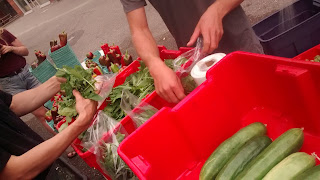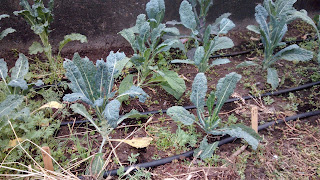Perhaps you have noticed that little chill in the air that arrives at night, or sometimes even earlier in the day? Or maybe you have remarked that the evening air has a distinct smell, a smell which I find rather difficult to describe, yet somehow I know that fall is in the air and that soon winter is coming...
 |
| Basil initiates flowers as days get shorter and a nightly chill sets in |
It is now officially fall. However, the changing season has been evident long before arriving at the calendar date, Sep. 22, which marks the vernal equinox. As we arrived for school, the full intensity of summer clung on desperately, with intense heat, and sunlight, only to be modified slightly by lingering smoke . Even though I had left to do research in Mexico for a month and was largely absent during the month of August, being back in the Lower Mainland, I was reminded of the oppressiveness of the smoke and heat that engulfed everything. The grass was so parched by this time, that it would shatter to a fine powder as it was tread on. Finally, a break...........
relief...... by the end of week, it rained.
At this time, the weather became more livable with reasonable temperatures. This shift was not the only change that was set in motion by the arrival of the first rains. The nighttime temperatures had started to drop to the low 10's creating a noticeable difference between the day and night temperatures.
 |
| Hazel cleaning the bin between harvests |
Similarly, in our weekly harvest these changes have become evident. At the third week of the semester, we were still able to harvest lots of heat loving summer annuals such as: tomatoes, peppers, okra, basil, cucumbers, and shiso; but these have noticeably slowed down in their ripening resulting in much lesser yields than the previous weeks harvests. We would have harvested zucchini, but that pretty much entirely succumbed to powdery mildew (picture below). We also harvested some more cold tolerant crops such as leafy greens - kale, lettuce, spinach, arugula; nasturtium leaves and flowers, hakurei turnips. Even the more cold hardy crops offered only modest harvests - it is a time of transition after all, and lots of our fall harvest crops have yet to reach sufficient maturity for harvest.
 |
| A meager tomato harvest |
 |
| Nic harvesting basil |
 |
| The peppers are still hanging in... |
 |
| Shiso |
 |
| Piper preparing the produce to be weighed |
The produce above is what we were able to harvest off the terrace. Additionally, we had potatoes and beans in cold storage from the previous week's harvest, and had a few students working with Torin to harvest celery, leeks, beets and corn that day. All of the produce was weighed, and then processed into bags and was then aggregated at around 11am, to be transported by truck to the Farmers Market at Minoru Plaza.
 |
| The last of the hakurei turnips |
 |
| Nasturtiums in their element |
 |
| Arugula |
 |
| Oak leaf lettuce |
As is usual, doing the market harvest leaves us with little time, but we do our best to attend to the needs of the terrace as much as time permits. For example, Jordan busied himself with the harvest of rye seed, and carrot seed, and then cleaning up the spent cucurbit plants (mostly zucchini). Some students and Mike set about tackling weeds with hoes in hand.
 |
| Jordan posing for the camera |
 |
| These plants gave up on life because of powdery mildew |
At the very end of class, all of the students congregated to hear Mike's report about the latest news with Garden City lands. It seems we have encountered another snag in gaining the right to farm the GC lands. The ALC has sent an order to Richmond municipal council to remove a foot of soil. For various reasons, the council does not agree with the order, and nor do our instructors. Mike explained that given the mandate of protecting soil for current and future farm use, adding 2 feet of non-native soil is counter to the purpose of the ALR. However, adding the extra soil is critical for two important reasons: the soils of GC lands are highly contaminated with led from past uses (rifle range, control tower), and by adding extra layers the risk of the led being bio-accumulated by produce is greatly reduced. The second reason, involves the greater context of climate change induced by anthropogenic activity - e.g. the accelerated release of GHG into the atmosphere. In this context, all the peat in GC lands is huge reservoir of organic carbon, which if cultivated in a conventional matter (ie: being drained and tilled) will quickly transform into a huge source of CO2 gas in short manner of time. In contrast, and even though minerals soils are not as productive as organic soils, they can actually increase in soil organic matter overtime with sound practices, thereby becoming a sink for atmospheric carbon. To summarize, adding a good layer of mineral soil overtop of the peat may actually help preserve thereby stopping it's degradation and release of CO2 gas. Given that maintaining the mineral soil cover is imperative, and the city is trying to resist this order.
 |
| Mike and his children (sorghum) |
With that, the class was over - actually, it had already ended 10 minutes before, but I think we were all intrigued to get caught up with the latest on the Garden City saga.
 |
| Assessing the state of the cherry tomatoes |
 Even though we are in autumn now, the sun and the heat came
by to say hello one last time this Tuesday!
Even though we are in autumn now, the sun and the heat came
by to say hello one last time this Tuesday!





































































